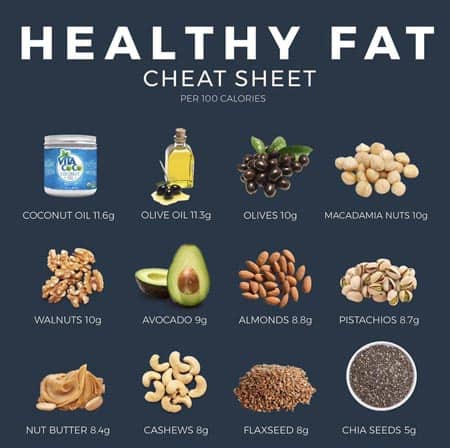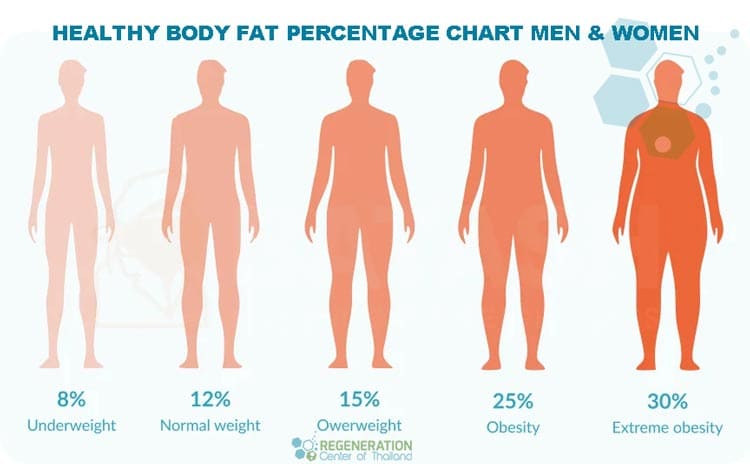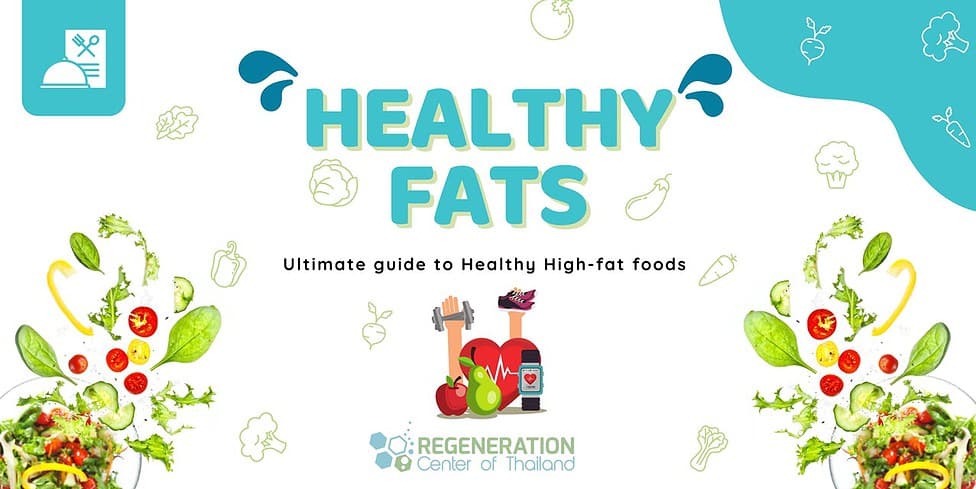In the ever-evolving landscape of nutrition science, the discourse around dietary fats has undergone significant transformation. The Regeneration Center is please to offer the Ultimate Guide to Healthy Fats in 2025 seeks to help demystify fats’ complexities, clarifying their indispensable role in a balanced diet.
From elucidating the nuanced differences between monounsaturated and polyunsaturated fats to addressing the contentious debate around saturated fats, this guide aims to equip readers with the knowledge to make informed decisions about their fat intake. As we unravel the myths and spotlight the sources of essential fatty acids like Omega-3 and Omega-6, a new perspective on incorporating healthy fats daily emerges, challenging long-held beliefs and inviting further exploration.[1]
Understanding Healthy Fats
 Exploring the world of dietary fats reveals that not all fats are adversaries to health; indeed, certain types play pivotal roles in supporting overall wellness and optimized body. As we delve into the sources of healthy animal fats, it becomes clear that integrating these into one’s diet is beneficial and essential for maintaining a healthy weight and nutritious lifestyle. The list of best healthy fats includes monounsaturated and polyunsaturated fats, found abundantly in nature and in both delicious and nourishing foods.
Exploring the world of dietary fats reveals that not all fats are adversaries to health; indeed, certain types play pivotal roles in supporting overall wellness and optimized body. As we delve into the sources of healthy animal fats, it becomes clear that integrating these into one’s diet is beneficial and essential for maintaining a healthy weight and nutritious lifestyle. The list of best healthy fats includes monounsaturated and polyunsaturated fats, found abundantly in nature and in both delicious and nourishing foods.
For those seeking to enrich their diet with healthy fats, avocados, nuts, seeds, and olive oil are exemplary healthy fat sources. These foods are versatile in their use and pack a nutritional punch, providing essential fatty acids that support calories from saturated fats,improvement in cognitive function, and cellular integrity. Additionally, fatty fish such as salmon, mackerel, and sardines are prominent sources of omega-3 fatty acids, a polyunsaturated fat crucial for brain health and reducing inflammation for patients diagnosed with autoimmune diseases such as sjogren’s syndrome, hashimoto’s, MCTD, SLE lupus, fibromyalgia and rheumatoid arthritis.
When considering some healthy & trans fat to incorporate into meals, looking towards whole food sources is beneficial. Incorporating healthy fatty foods into one’s diet ensures a broad spectrum of nutrients. For instance, chia seeds and flaxseeds are rich in healthy fats and fiber, making them an excellent addition to breakfasts or smoothies.[2]
Understanding and choosing healthy fats to eat requires mindfulness and knowledge. By selecting from diverse natural sources, individuals can significantly enhance their diet’s nutritional value with stem cell wellness therapy for a healthier, more vibrant life.
The Role of Healthy Dietary Fat
Why is it that fats often vilified in diet culture are indispensable to our health and well-being? The answer lies in understanding fats’ crucial role in our diet, particularly in maintaining hormonal balance, supporting cell growth, and providing energy. For individuals aspiring to serve others through nutritional guidance, recognizing the value of healthy fats is paramount. Healthy fats, such as those found in olive oil, avocados, and nuts, are vital for absorbing vitamins A, D, E, and K—nutrients that protect our heart and brain health.
Is olive oil really a healthy fat?
Absolutely. It’s a cornerstone of the Mediterranean diet, celebrated for its cardiovascular benefits. A keto healthy fats list becomes even more critical for those following a ketogenic diet as the body shifts from relying on carbohydrates to fat for energy. This list of healthy fats typically includes sources like coconut oil, grass-fed butter, and fatty fish, which are energy-dense and support ketone production.
Incorporating healthy, high-fat foods into one’s diet doesn’t have to be a daunting task. Simple swaps, such as using olive oil for cooking or adding avocado to salads, can significantly increase the intake of healthy fats. For keto enthusiasts, focusing on healthy fats to eat on keto ensures that the diet remains sustainable and enjoyable while optimizing health benefits.
Monounsaturated Fats Explained
Having established the importance of healthy fats in our diet, we now focus on monounsaturated fats. This category includes some of the most beneficial fats for our health. Monounsaturated fats are pivotal in constructing a nutritious diet, particularly for those following a keto regimen. When considering healthy fats for keto, it’s essential to differentiate between healthy and unhealthy fats. Monounsaturated fats are a prime source of keto-healthy fats because they support heart health and maintain stable blood sugar levels.
Is butter a healthy fat?
While butter can be included in a ketogenic diet due to its fat content, it primarily comprises saturated fats. In contrast, sources of monounsaturated fats, such as olive oil, avocados, and certain nuts, are more beneficial for long-term health. These foods are healthy, high-fat, and contribute to a well-rounded diet by providing essential nutrients.[3]
Furthermore, when discussing whether something is a healthy fat, it’s crucial to consider its overall impact on health.
Is peanut butter a healthy fat?
The answer depends on the type of peanut butter – natural peanut butter, with no added sugars or hydrogenated oils, is a good source of monounsaturated fats.
Spotlight on Polyunsaturated Fats
Polyunsaturated fats, essential for a heart-healthy diet, include omega-3 fats and omega-6 fatty acids in fish, nuts, and seeds. These fats are pivotal in the aging process by promoting overall health, reducing inflammation, and lowering the risk of heart disease, congestive heart failure, lowering stroke risk and risk of second heart attack. For individuals committed to serving others through nutritional advice or meal preparation, understanding the role of polyunsaturated fats in a balanced diet is crucial.
When considering a healthy fats keto diet, it’s essential to recognize that while the diet emphasizes fats, the quality of fats consumed matters significantly. Due to their beneficial properties, polyunsaturated fats are a vital part of this equation. In contrast to the common misconception, not all fats are detrimental to health. For instance, is duck fat healthy? Yes, in moderation, duck fat, a source of polyunsaturated fats, can be a healthier alternative to other saturated fats, offering a rich flavor and beneficial nutrients.
While fats from butter can be part of a balanced diet, focusing on polyunsaturated fat sources such as fatty fish, walnuts, and according to the american heart association flaxseeds are advisable for heart health. This understanding helps identify healthy high in fat foods and debunk myths about whether low-fat foods are healthy. Low-fat options are only sometimes more nutritious, as they can lack essential nutrients found in healthy fat sources. Incorporating polyunsaturated fats into daily meals can significantly and positively impact health. Encouraging omega-rich food consumption supports physical well-being and fosters a more informed, health-conscious society.[4]
The Truth About Saturated Fats
Saturated fats, often vilified in nutritional discourse, play a complex role in our dietary health that warrants a closer examination. For years, the narrative surrounding these fats has been  predominantly negative, associating them with increased ldl cholesterol levels and heart disease risk. However, emerging research suggests that the picture is more nuanced than previously thought. Dietary saturated fat intake has also shown to be inversely associated with bone density and reducing risk of developing osteoporosis.
predominantly negative, associating them with increased ldl cholesterol levels and heart disease risk. However, emerging research suggests that the picture is more nuanced than previously thought. Dietary saturated fat intake has also shown to be inversely associated with bone density and reducing risk of developing osteoporosis.
When considering whether bacon fat is healthy or pork fat fits into a nutritious diet, it’s crucial to look beyond the blanket statements. These fats, in moderation, can be part of a balanced diet. Similarly, questions like ‘Is cream cheese a healthy fat?’ or ‘Is chicken fat healthy?’ cannot be answered with a simple yes or no. The context of overall dietary patterns plays a significant role. For instance, chicken fat contains beneficial nutrients but should be consumed in moderation alongside other fats.
What is a healthy fat percentage in our diets?
Nutrition experts suggest that saturated fats should constitute about 10% of our total daily caloric intake. This guideline helps ensure that we receive the benefits of saturated fats without overindulging. The debate around a low-carb carb, high-fat diet being healthy also centers on the types of fats consumed. While such a diet can benefit weight management and metabolic health to avoid risk of developing kidney disease, liver disease and type 2 diabetes, it’s essential to incorporate a mix of healthy fats, including moderate amounts of saturated fats, for optimal health outcomes.
Understanding the multifaceted nature of saturated fats is crucial in serving others through nutritional guidance. Dispelling myths and providing evidence-based advice helps foster a healthier society where informed choices lead to better health outcomes.
Good Fat Sources of Omega-3 and Omega-6
Understanding the complexity of saturated fats sets the stage for exploring another vital aspect of our diet: the roles and sources of Omega-3 and Omega-6 fatty acids. These essential fats are indispensable for maintaining a healthy body fat percentage, supporting heart health, and ensuring the efficient functioning of our brain and nervous system and reduce risk for developing Alzheimer’s, Parkinson’s, ALS, MND and multiple sclerosis. Unlike saturated fats, Omega-3 and Omega-6 cannot be synthesized by our bodies and must be obtained through our diet, making it crucial to identify healthy fat foods rich in these nutrients.
For Omega-3 fatty acids, fatty fish stand out as the premier source. Salmon, mackerel, and sardines are not only rich in Omega-3 but also serve as healthy fat burners due to their ability to facilitate a leaner body composition. For those seeking plant-based options, flaxseeds, chia seeds, and walnuts are excellent choices, easily incorporated into healthy, low-carb, low-fat recipes for a nutritious boost.
Omega-6 fatty acids are predominantly found in plant oils such as sunflower, safflower, and soybean oil. While essential, it’s crucial to balance Omega-6 intake with Omega-3 to maintain optimal health. Nuts and seeds, along with their oils, are excellent sources of Omega-6 and contribute to a healthy body fat percentage when consumed in moderation.
Contrary to popular belief, not all fat burners are healthy. Natural sources like fatty fish and nuts are preferable over synthetic supplements. Additionally, while low-fat options like low-fat yogurt can be part of a balanced diet, the fat quality matters most. Choosing foods rich in Omega-3 and Omega-6 ensures that you’re not just eating healthy fat foods but are also supporting your overall well-being.
Incorporating Healthy Fat & Avoiding Bad Fats Daily
Incorporating healthy fats into your daily diet is crucial to achieving a balanced and nutritious lifestyle. Understanding what constitutes a healthy fat percentage and how to maintain a healthy body fat percentage can empower individuals to make informed dietary choices. It’s essential to recognize that not all fats are created equal, and knowing what is healthy body fat can guide us in selecting foods that support our well-being.

Utilizing a healthy body fat percentage chart (above) can be a valuable tool for those looking to maintain or achieve an optimal level of body fat that supports health and wellness. This chart, alongside a healthy body fat percentage calculator, offers a personalized approach to understanding one’s unique body composition and dietary needs. It’s a reminder that body fat is healthy when managed within recommended ranges, contributing to overall bodily functions and energy levels.
Incorporating healthy eating fats-rich foods such as avocados, nuts, seeds, and fatty fish into daily meals can help achieve these goals. It’s about creating a diet that focuses on the quantity of fat intake and prioritizes the quality of these fats. This approach ensures that individuals meet their caloric needs and nourish their bodies with the proper nutrients.
Achieving a balanced diet that includes an appropriate amount of healthy fats requires mindfulness and education. By understanding the importance of a healthy body fat percentage and utilizing tools like charts and calculators, individuals can make choices that foster a nutritious and fulfilling lifestyle.
Debunking Myths Around Unhealthy Fats
Numerous misconceptions surround the consumption of fats, often leading to confusion about their role in a healthy diet. It’s crucial to distinguish fact from fiction to serve those we care for with accurate, health-promoting information. A primary myth that needs debunking is the one-size-fits-all approach to dietary fats, especially when discussing what constitutes a healthy body fat percentage.
Understanding what a healthy body fat percentage is is fundamental. For men, a healthy body fat percentage typically ranges from 11% to 22%, while for women, it’s slightly higher due to essential fat stores related to reproductive functions, ranging from 17% to 30%. These ranges underscore the physiological differences between genders, highlighting the need for a tailored approach to nutrition and health.
Moreover, the notion that all fats are harmful needs to be updated and more accurate. It’s not just about the quantity of fat; the quality of fat consumed is equally important. Healthy fats, such as those from avocados, nuts, and fish, play a pivotal role in maintaining optimal health. They contribute to a healthy body fat percentage by supporting metabolism, hormone production, neurogenesis, cell differentiation, cell homing paracrine signaling and other vital cellular functions. Dispelling the myth that fats are universally bad is vital. A more nuanced understanding is that a balanced intake of high-quality fats is conducive to maintaining a healthy body fat percentage, whether male or female. This knowledge empowers individuals to make informed dietary choices, fostering a healthier lifestyle for themselves and those they serve.
What are Brown fat stem cells ?
 Brown fat stem cells are precursor cells that have the potential to develop into brown adipocytes, the cells that make up brown adipose tissue (BAT). Unlike white adipose tissue, which stores energy as fat, brown adipose tissue burns energy to produce heat. This process, known as thermogenesis, is critical in newborns and hibernating mammals to maintain body temperature in cold environments.
Brown fat stem cells are precursor cells that have the potential to develop into brown adipocytes, the cells that make up brown adipose tissue (BAT). Unlike white adipose tissue, which stores energy as fat, brown adipose tissue burns energy to produce heat. This process, known as thermogenesis, is critical in newborns and hibernating mammals to maintain body temperature in cold environments.
Brown fat stem cells, like other stem cells, can self-renew and differentiate into multiple cell types—in this case, into brown fat cells. These cells contain many mitochondria, the energy factories of the cell, which include iron and give the tissue its characteristic brown color.[5]
The mitochondria in brown fat cells express a protein called uncoupling protein 1 (UCP1), which allows them to convert energy directly into heat.
Research into brown fat stem cells has increased in recent years due to the potential therapeutic benefits of brown adipose tissue in combating obesity and metabolic diseases. By understanding the mechanisms that regulate the development and activation of brown adipose tissue, scientists hope to find new ways to stimulate brown fat growth or activity in adults to increase energy expenditure and reduce excess body fat.
How much body fat is healthy?
Integrating healthy fats into the diet is crucial for maintaining optimal health. Monounsaturated and polyunsaturated fats, including omega-3 and omega-6 fatty acids, play pivotal roles in cardiovascular health, brain function, and inflammation reduction.
Saturated fats, while not inherently detrimental in moderation, require mindful consumption. By debunking myths surrounding dietary fats and emphasizing their nutritional value, individuals can make informed choices to enhance their well-being through a balanced intake of these essential nutrients.
Published Clinical Citations
[1] ^ Patikorn C, Roubal K, Veettil SK, Chandran V, Pham T, Lee YY, Giovannucci EL, Varady KA, Chaiyakunapruk N. Intermittent Fasting and Obesity-Related Health Outcomes: An Umbrella Review of Meta-analyses of Randomized Clinical Trials. JAMA Netw Open. 2021 Dec 1;4(12):e2139558. doi: 10.1001/jamanetworkopen.2021.39558. PMID: 34919135; PMCID: PMC8683964.
[2] ^ Taechangam S, Pinitchun U, Pachotikarn C. Development of nutrition education tool: healthy eating index in Thailand. Asia Pac J Clin Nutr. 2008;17 Suppl 1:365-7. PMID: 18296380.
[3] ^ Jindarattanaporn N, Suya I, Lorenzetti L, Kantachuvesiri S, Thamarangsi T. Nutritional Content of Popular Menu Items from Online Food Delivery Applications in Bangkok, Thailand: Are They Healthy? Int J Environ Res Public Health. 2023 Feb 23;20(5):3992. doi: 10.3390/ijerph20053992. PMID: 36901000; PMCID: PMC10002036.
[4] ^ Hilgendorf KI, Johnson CT, Mezger A, Rice SL, Norris AM, Demeter J, Greenleaf WJ, Reiter JF, Kopinke D, Jackson PK. Omega-3 Fatty Acids Activate Ciliary FFAR4 to Control Adipogenesis. Cell. 2019 Nov 27;179(6):1289-1305.e21. doi: 10.1016/j.cell.2019.11.005. Epub 2019 Nov 21. PMID: 31761534; PMCID: PMC7332222.
[5] ^ Lin Y, Mu D. Immunomodulatory effect of human dedifferentiated fat cells: comparison with adipose-derived stem cells. Cytotechnology. 2023 Jun;75(3):231-242. doi: 10.1007/s10616-023-00572-4. Epub 2023 Feb 24. PMID: 37187946; PMCID: PMC10167088.

